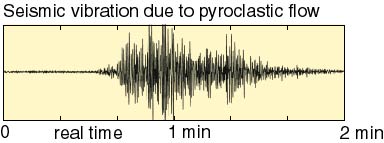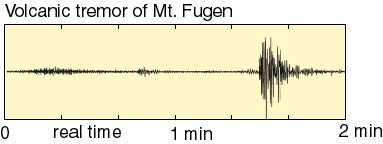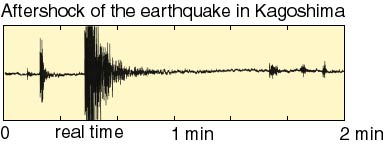  Top of Part 4
Top of Part 4
  Previous p.
Previous p.
  Next page
Next page
|
 A present day's seismograph A present day's seismograph
 records the data of records the data of
 seismic oscillation seismic oscillation
 on magnetic tapes on magnetic tapes
 or memory tips as electric signals. or memory tips as electric signals.
 We can therefore convert We can therefore convert
 this oscillation this oscillation
 into acoustic oscillation into acoustic oscillation
 to hear as "sound". to hear as "sound".

 For example, For example,
 if we replay the data if we replay the data
 of electric signals of of electric signals of
 seismic oscillations seismic oscillations
 100 times as fast as 100 times as fast as
 original speed, then 1 minute original speed, then 1 minute
 in the real observation time in the real observation time
 is shortened (compressed) is shortened (compressed)
 to be 0.6 second; to be 0.6 second;
 thus the frequency of thus the frequency of
 the seismic oscillation the seismic oscillation
 is multiplied by is multiplied by
 100 times, and we can hear 100 times, and we can hear
 a seismic oscillation of 10Hz a seismic oscillation of 10Hz
 as a sound of 1,000Hz. as a sound of 1,000Hz.

 Three different kinds Three different kinds
 of seismic vibration are of seismic vibration are
 presented below. presented below.
 Converting these vibration Converting these vibration
 into acoustic oscillation, into acoustic oscillation,
 we can hear these as we can hear these as
 different "sounds". different "sounds".
 Thereby we can distinguish Thereby we can distinguish
 vibrations due to vibrations due to
 pyroclastic flow pyroclastic flow
 or volcanic tremor or or volcanic tremor or
 aftershock, and we aftershock, and we
 can estimate can estimate
 what happens under (or on) what happens under (or on)
 the ground. the ground.

 Select a sound type Select a sound type
 fit to your PC fit to your PC
 from the menu on the from the menu on the
 right-hand side of right-hand side of
 the figures below, the figures below,
 and click! and click!
 You can listen to three You can listen to three
 different types of seismic vibrations. different types of seismic vibrations.
 These vibrations are These vibrations are
 replayed 81.9 times faster than replayed 81.9 times faster than
 the original speed. the original speed.

|

 Top of Part 4
Top of Part 4

 Previous p.
Previous p.

 Next page
Next page
 A present day's seismograph
A present day's seismograph
 records the data of
records the data of
 seismic oscillation
seismic oscillation
 on magnetic tapes
on magnetic tapes
 or memory tips as electric signals.
or memory tips as electric signals.
 We can therefore convert
We can therefore convert
 this oscillation
this oscillation
 into acoustic oscillation
into acoustic oscillation
 to hear as "sound".
to hear as "sound".

 For example,
For example,
 if we replay the data
if we replay the data
 of electric signals of
of electric signals of
 seismic oscillations
seismic oscillations
 100 times as fast as
100 times as fast as
 original speed, then 1 minute
original speed, then 1 minute
 in the real observation time
in the real observation time
 is shortened (compressed)
is shortened (compressed)
 to be 0.6 second;
to be 0.6 second;
 thus the frequency of
thus the frequency of
 the seismic oscillation
the seismic oscillation
 is multiplied by
is multiplied by
 100 times, and we can hear
100 times, and we can hear
 a seismic oscillation of 10Hz
a seismic oscillation of 10Hz
 as a sound of 1,000Hz.
as a sound of 1,000Hz.

 Three different kinds
Three different kinds
 of seismic vibration are
of seismic vibration are
 presented below.
presented below.
 Converting these vibration
Converting these vibration
 into acoustic oscillation,
into acoustic oscillation,
 we can hear these as
we can hear these as
 different "sounds".
different "sounds".
 Thereby we can distinguish
Thereby we can distinguish
 vibrations due to
vibrations due to
 pyroclastic flow
pyroclastic flow
 or volcanic tremor or
or volcanic tremor or
 aftershock, and we
aftershock, and we
 can estimate
can estimate
 what happens under (or on)
what happens under (or on)
 the ground.
the ground.

 Select a sound type
Select a sound type
 fit to your PC
fit to your PC
 from the menu on the
from the menu on the
 right-hand side of
right-hand side of
 the figures below,
the figures below,
 and click!
and click!
 You can listen to three
You can listen to three
 different types of seismic vibrations.
different types of seismic vibrations.
 These vibrations are
These vibrations are
 replayed 81.9 times faster than
replayed 81.9 times faster than
 the original speed.
the original speed.



